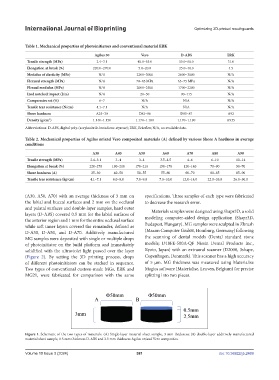Page 389 - IJB-10-3
P. 389
International Journal of Bioprinting Optimizing 3D-printed mouthguards
Table 1. Mechanical properties of photoinitiators and conventional material ERK
Agilus 30 Vero D-ABS ERK
Tensile strength (MPa) 2.4–3.1 40.0–55.0 55.0–60.0 31.0
Elongation at break (%) 220.0–270.0 5.0–20.0 25.0–40.0 4.5
Modulus of elasticity (MPa) N/A 2200–3000 2600–3000 N/A
Flexural strength (MPa) N/A 70–85 MPa 65–75 MPa N/A
Flexual modulus (MPa) N/A 2000–2500 1700–2200 N/A
Izod notched impact (J/m) N/A 20–30 90–115 N/A
Compressive set (%) 6–7 N/A N/A N/A
Tensile tear resistance (N/cm) 4.1–7.1 N/A N/A N/A
Shore hardness A25–30 D83–86 D85–87 A92
3
Density (g/cm ) 1.140–1.150 1.170–1.180 1.170–1.180 0.935
Abbreviations: D-ABS, digital poly-(acrylonitrile-butadiene-styrene); ERK, Erkoflex; N/A, no available data.
Table 2. Mechanical properties of Agilus or/and Vero composited materials (A) defined by various Shore A hardness in average
conditions
A30 A40 A50 A60 A70 A80 A90
Tensile strength (MPa) 2.4–3.1 3–4 3–4 3.5–4.5 4–6 6–10 10–14
Elongation at break (%) 220–270 190–210 170–210 150–170 120–140 70–90 50–70
Shore hardness (A) 25–30 40–50 50–55 55–60 60–70 80–85 85–90
Tensile tear resistance (kg/cm) 4.1–7.1 6.0–8.0 7.0–9.0 7.0–10.0 12.0–14.0 22.0–26.0 26.0–30.0
(A30, A50, A70) with an average thickness of 3 mm on specifications. Three samples of each type were fabricated
the labial and buccal surfaces and 2 mm on the occlusal to decrease the research error.
and palatal surfaces and double-layer samples, hard outer Materials samples were designed using Shapr3D, a solid
layers (D-ABS) covered 0.5 mm for the labial surfaces of
the anterior region and 1 mm for the entire occlusal surface modeling computer-aided design application (Shapr3D,
while soft inner layers covered the remainder, defined as Budapest, Hungary). MG samples were sculpted in Zbrush
D-A30, D-A50, and D-A70. Additively manufactured (Maxon Computer GmbH, Homburg, Germany) following
MG samples were deposited with single or multiple drops the scanning of dental models (Dental standard stone
of photoinitiator on the build platform and immediately models; D18FE-500A-QF Nissin Dental Products Inc.,
solidified with the ultraviolet light passed over the layer Kyoto, Japan) with an extraoral scanner (D2000, 3shape,
(Figure 2). By setting the 3D printing process, drops Copenhagen, Denmark). This scanner has a high accuracy
of different photoinitiators can be stacked in sequence. of 5 µm. MG thickness was measured using Materialise
Two types of conventional custom-made MGs, ERK and Magics software (Materialise, Leuven, Belgium) for precise
MG21, were fabricated for comparison with the same splitting into two pieces.
Figure 1. Schematic of the two types of materials. (A) Single-layer material sheet sample, 3 mm thickness; (B) double-layer additively manufactured
material sheet sample, 0.5 mm thickness D-ABS and 2.5 mm thickness Agilus or/and Vero composites.
Volume 10 Issue 3 (2024) 381 doi: 10.36922/ijb.2469

